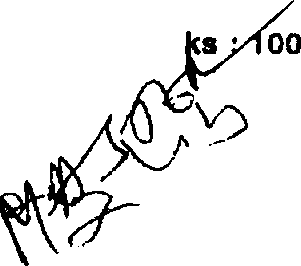University of Mumbai 2007-6th Sem B.E Electrical and Electronics Engineering Signal Processing-II - Question Paper
y. j I,?
U {revised couBsn
Con. 2695-07.
(REVISED COURSE)
|
ND-539 [ Total Mar | |
 |
T hn< |
(3 Hours)
N.B.{i) Question No. 1 Is compulsory.
(2) Attempt in. all five questions including Question No. 1.
(3) Figures to the right Indicate full marks. , i a
1. (a; A system has an impulse response
h(n) - (0-2)n cos
nn
u(n)
Plot poles ard zeros.
Given x(n) = f a, b, c, 1, 0, 1, c, b ). Can this sequence have X(k) as shown below ? X(k) = ((2 + a + 2b + 2c), (3 4- j 4), (2 + jO-5), (-3 + j 2), (2), (~3 + j 2), (2 + j 0-5), (3 + j 4)} where a, b aid c are real numbers. Justify your answer.
(b)
(c)
<d)
Explain the effect of windowing operation on the desired frequency response.
Obtain Cascade realization of the given system function using minimum number of multiplications. Note that the two sections havo linear phase symmetry In their impulse responses.
H(z)
2 (a) An FIR filter s described by the difference equation y(n) = x(n) + x(n - 10)
(i) Compute and sketch its magnitude and phase response 8
(ii) Determino its response to the Input 2
x(n) =10 + 5 cos(2n: n/5 + tc/2), - oq < n < oo.
<b) Let x,(n) = { 1, 2, 3, 4 J and x2(n) = { 5, 6, 7, 8 }. Find X,(k) and X2(k) of the above 10 sequences by performing DFT computation only once.
3. (a) Determine circular convolution and linear convolution using circular convolution of the following 10 sequences :
x,(n) = {4, 3.2 }
*2<n) = { 1.2, 1,3, 4,2}.
(b) Using trapezoidal rulG of intogration show that
s'T7f| n = ftan(v%).
Where U is analog froquoncy and W is digital lrequency ? What do you mean by non-linear 10 warping ?
4. (a) Describe the four types of linear phase FIR filters and derive the conditions for having 10 compulsory zeros at z = +1 or -1 for types 2, 3 and 4 linear phase systems.
(b) A digital low-pass filter is required to meet the following specifications :
Pass band ripple : < 1 dB Pass band edge : 4 kHz Stop band attenuation : > 40 dB Stop band edge : 6 kHz Sampling rate : 24 kHz
Find the order of Butterworth and Chebyshev filter using bilinear transformation.
fojijPSSgj? Ar -
ff~ '>07 <]*%>-
*5. (a) The desired frequency response of a low-pass filter is 10
' : Hd (e|w) = e"3** (or
= 0 otherwise Determine H(e') for M = 7 using Blackman window.
{b) Find the inverse DTFT of X(e*w) = 5(w) -tc < w < jr. 4
(c) Consider the DFT pair x(n) <> XDFtO<) 6
Where x(n) = { 1, 2, 1, 0 ) and XdftM = { 4, j 2, 0, | 2 }
Find the DFT of
(I) y(n) = x(n - 2)
(ii) y(n) = x*(n).
6. (a) Determine the impulse response for the Cascade of two linear time-invariant systems having 10 impulse response.
h,(n) = u (n) and h2 (n) = ({) u (n) .
Make use of convolution property to get the answer.
(b) Consider the causal linear shift*invarianf filter with system function 10
H (z) 10.875r<
(1 + 0-2z_t + 0;9z"2)(l -0-7Z~')
Draw a signal flow-graph for this system using
(i) Direct form II
(ii) A Cascade of first order system realized in direct form II.
7. Write notes on the following : 20
(a) DSP processors
(b) Properties of DFT
(c) Digital oscillator
(d) Linear FIR filtering of long data sequence using DFT.
|
Attachment: |
| Earning: Approval pending. |
